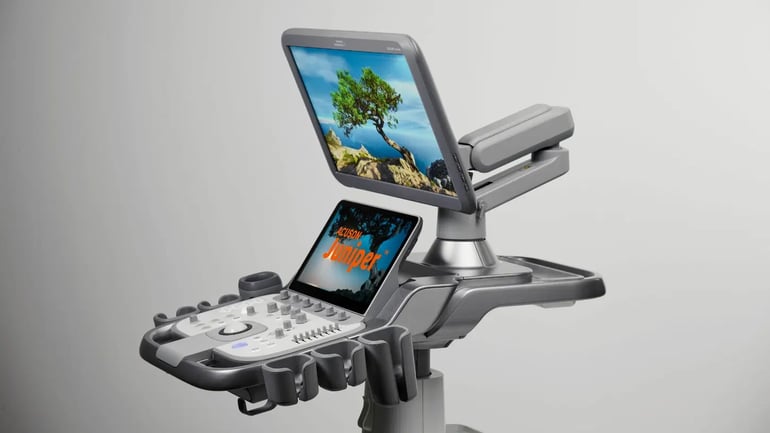![]() Interventional cardiologists have unique needs. The highly specialized nature of cardiology is such that you need special equipment and software to do your best work and improve clinical workflows, staff experience and, ultimately, patient outcomes.
Interventional cardiologists have unique needs. The highly specialized nature of cardiology is such that you need special equipment and software to do your best work and improve clinical workflows, staff experience and, ultimately, patient outcomes.
A new era of interventional cardiology is here, and with it comes new technologies designed from the ground up to meet the specific clinical burden of cardiology. With American Heart Month happening as we speak, we thought this would be the perfect time to conduct a cardiac systems review, looking at what has the healthcare community excited in 2023 and beyond.
Keep reading to find out the latest in cardiac ultrasound, the robotic systems changing the game for what’s possible in traditional cardiac intervention, and why cardiac MRI is having such a big moment.
Ultrasound to the Rescue
Echocardiography is a unique discipline, and you require technology that empowers your sonography team to do their absolute best work. If it’s been some time since you upgraded your ultrasound fleet, you may not realize some of the technologies on board some cardiovascular ultrasound systems.
The Stress Echo application from Siemens Healthineers provides tools for ECG-triggered acquisition, display, selection, comparison, evaluation and archiving of multiple cardiac loops during these types of examinations. Meanwhile, the syngo Arterial Health Package is noninvasive, providing a method of evaluation of cardiovascular risk and an advanced quantification application to access arterial health.
A number of advancements have also been made to ease the workload of sonographers. Ergonomics have been considered at every stage of the process, with intuitive control panels and touch displays that respond as needed while also being within easy reach. And more transducer ports mean less back and forth between or even during exams.
The relatively small size of these systems is also important to consider. Systems such as the ACUSON Juniper weigh up to 27% less than other systems in the same class, with all the technology you rely on fitting within a footprint that’s 36% smaller than other systems. Portable systems also provide cardiac applications right at the patient’s bedside, making them a go-to for emergency and critical care when time is of the essence.
Transducers have come a long way too. Next-generation InTune transducer technology has advanced materials, optimization and manufacturing that results in the highest signal fidelity throughout the entire imaging chain. A comprehensive cardiac solution, built for comfort of your team and your patient, addresses a full range of patient sizes, ages and approaches. Depending on your needs, you can choose from a variety of vector, linear, CW and other transducers to suit your unique clinical needs.
The Future of Intervention is Robotic
Interventional cardiologists have their work cut out for them in the cath lab. Radiation dose risks necessitate heavy lead aprons, meaning orthopedic injuries are quite common. And during the procedure itself, an interventionalist will often encounter complex lesions and difficult anatomical challenges that can extend the expected length of the procedure.
In such a difficult environment, many are turning to endovascular robotics as an answer. Systems such as the Corindus CorPath GRX allow you to perform your procedures from a radiation-shielded workspace. Ideally, this would also help you experience less strain and fatigue.
The robotic system helps you navigate anatomy thanks to automated procedural movements and precise anatomical measurements. It aids in choosing the appropriate stent and in positioning the device. The robotic nature of the system also means procedures can be standardized in a bid to reduce variability. You benefit from consistency and predictability, particularly for lesion crossing and guidewire navigation.
Whether or not you ultimately decide to pivot to robotics for complex coronary interventions, there’s never been a better time to explore this technology (particularly if muscle strain has been on your mind as of late)..webp?width=1448&height=815&name=Corindus%20CorPath%20GRX%20(2).webp)
Cardiac-Focused MRI Is Having a Moment
For too long, cardiologists who wanted to take advantage of the unique benefits of MRI for their patients have been forced to utilize whatever scanner was on offer from their health system. To get truly cardiac-focused imaging would often require upgrading to advanced (and expensive) add-on packages that, at best, shoehorned cardiac applications into a scanner not expressly built for that purpose. As a result, true cardiac MRI has been somewhat of a rarity among clinicians.
That’s beginning to change thanks to specific cardiac-focused MRI scanners that come with all the cardiac-related tools and applications a radiologist would need to do their best work. Built to minimize variability between patients and reduce the movements that can make high-quality results difficult to achieve, these cardiac-specific systems could be a gamechanger for cardiology as they become more common even outside the research realm.
The MAGNETOM Sola Cardiovascular Edition, for instance, automatically adjusts to patient biovariability to overcome unwarranted variations in cardiac MRI examinations. On this 1.5T system, you can conduct cardiac MRI exams without ECG leads thanks to a tool called BioMatrix Beat Sensor. Free breathing also becomes possible thanks to Compressed Sensing Cardiac Cine, whose compressed sensing segmented technique supports high spatial and temporal resolution with very short breath holds.
When you rely on an MRI system that has all the necessary cardiac applications out the gate, you benefit from the peace of mind that comes from knowing you’ll be able to offer your team and your patients an incredible experience. You can spend less time wondering “is this possible?” and more time getting to the important business of serving your community..webp?width=1448&height=815&name=MAGNETOM%20Sola%20Cardiovascular%20Edition%20(2).webp)
Get to the Heart of the Matter
American Heart Month marks an opportunity to revisit current workflows and best practices to see where there might be areas of potential improvement.
The technology supporting cardiac imaging has evolved dramatically over just a few short years. The time is now to explore what’s possible for your practice.






Comments